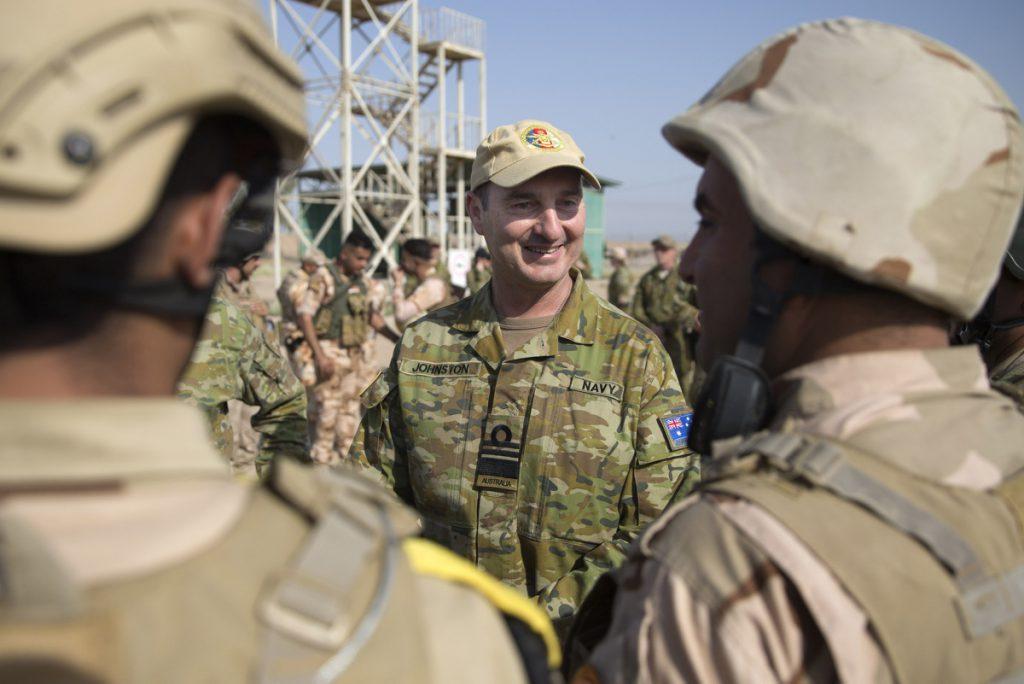
In the ADF’s Joint Operations Command, it’s referred to as the ‘battle rhythm’—a constant series of analyses and judgements about short- and long-term threats to the nation and the region.
A top security facility near the NSW town of Bungendore and a 30-minute drive from Canberra, HQ JOC has been commanded by the chief of joint operations, Vice Admiral David Johnston, since May 2014. Johnston oversees the planning and execution of Australia’s military operations and training exercises at home and overseas.
That can involve anything from dispatching ships and aircraft to help a neighbour stricken by a cyclone to making a decision on whether an Islamic State terror group target in Iraq or Syria should be bombed by RAAF jets.
Johnston tells The Strategist that the battle rhythm is a cycle of events in his headquarters. At JOC, there’s a set of NATO-style groups designed to work independently or closely together—an operations branch, a planning branch, an intelligence branch, a support branch (which has access to all the logistics required, including what’s needed for the medical response), a training and evaluation branch, and a communications branch.
Parallel streams of immediate and long-term planning bring the teams of specialists together to deal with emerging situations. ‘We take a vertical slice from groups with very specific responsibilities’, says Johnston. ‘Then we take a horizontal cut across them to bring them together.’
JOC leads all of the operations the ADF is engaged in—from domestic support to the community, be that after a civil disaster or terrorism, all the way through to activity overseas. ‘The fact we command operations is relatively well known, but many other parts of what we do are less well understood but are very important to us’, Johnston says. That includes constant contingency planning. ‘As the chief of the ADF and the Defence Department secretary form a view of areas where we may need to provide advice to government, we will work on a military option that could be presented. We maintain standard contingency plans, emergent ones for issues as they become apparent to us. I can do my own assessment of what’s occurring based on the many specialists who are here or a top–down approach that may come from government.’
‘We have a really clear purpose’, Johnston says. ‘Everybody who works here knows what we’re about.’ That’s one of the reasons the first principles review of Defence, released in 2015, didn’t touch the ADF’s operational planning, he says. ‘JOC is really aligned with what they were trying to achieve. There are clear accountabilities and clear responsibilities. I know exactly what’s expected of me by Defence, but it trickles down through the whole organisation. We know what we’re about. There’s no ambiguity. We’re very clear on our purpose and what’s expected of us.’
Activity at JOC is triggered by events, and information flows in constantly from sources ranging from intelligence agencies to global news feeds monitored on giant screens.
Planning sessions can be set in motion by a task as mundane as monitoring weather forecasts. ‘We might think that one’s looking like it’s moving towards Fiji’, says Johnston. ‘Let’s start doing some work on what we have available and how we might manage a response. That’s what we call our “deliberate cycle”.’
There’s a ‘short circle loop’ which involves activities such as watching the news and evaluating intelligence and events occurring around the world. ‘But around it, really importantly, is a deliberate cycle where we aim to lift ourselves out of the here and now to make sure we have a long-term vision as well’, says Johnson. ‘And then we bring those two together and prioritise where we’re applying effort across them.’
JOC watches to see what elements in Australia’s environment are changing and what implications that has and how the impact can be mitigated, says Johnston. Then he must decide if the operational ADF should handle it or if he needs to reach out to other parts of Defence or through them to other government agencies.
‘It’s very robust and I’m very pleased to see how well it’s working in the headquarters because we cope with both and we have a structure that is adept at fixing the immediate but not forgetting the long term.’
Johnston’s strong message to personnel at JOC is that as the ADF changes around them with the introduction of equipment such as the navy’s new landing ships and the RAAF’s advanced and integrated new aircraft or the ADF’s cyber capabilities, ‘we need a fifth generation headquarters to match a fifth generation force’.
Many contingency plans are never acted on. ‘If we see long-term security risks in a number of areas important to us nationally—we hope most won’t eventuate—and if we think the government will seek an answer, I can be tasked by the chief of the ADF and the secretary to develop a plan’, Johnston says.
‘Or, if I think I’m likely to be tasked at some point, then let’s start that work now so that we’re well placed to be able to provide a response is it’s required. A few of those plans are developed to a significant level and we will then park them and have them available to us is we need to bring them out.’